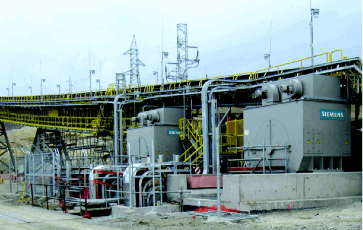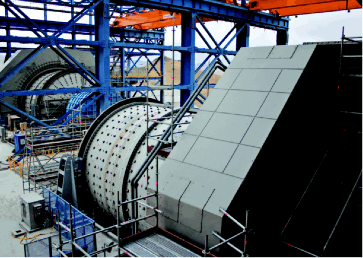Gearless drive systems for conveyors or mills can simplify installation, increase machine efficiency and reduce maintenance costs, according to a company that’s been a pioneer in the technology
 |
| A Siemens gearless drive system powers a 6.5-km-long overland conveyor belt at the Antapaccay copper project in Peru. With gearless drive systems, a low-speed synchronous motor replaces the high-speed asynchronous motor, gearboxes and couplings required in conventional gearbox-based systems. |
Earlier this year, Siemens AG’s Drive Technology Division hosted an online press conference at which it presented the
technical specifications of its gearless drive conveyor installation at the new Antapaccay copper mine in Peru—a 5,260-mt/h-capacity overland belt that was commissioned in 2012 and has been operating at production levels since October. It also provided background information on why its gearless drive systems for low-speed mine equipment such as conveyors and mills offer an attractive alternative to traditional gearbox-driven systems for these types of applications.
Although not directly related to plant design technology, the issues that Siemens said its gearless systems are designed to overcome play an important role in plant efficiency: After all, if the desired speed, availability and power performance demanded from a main overland conveyor system feeding a plant isn’t consistently achieved, even the most well-designed plant will have a hard time meeting its throughput target.
The Siemens presenters noted that raw materials are nearly always excavated in harsh environments—but new mines are increasingly located in inhospitable environments: at high altitude, in deserts or arctic cold. Underground mines are getting deeper and more complex. Infrastructure costs for energy and water supply are climbing. Meanwhile, higher tonnages of lower grade ore are being excavated and transported over longer distances.
To deal with these challenges and to meet increasingly stringent requirements for equipment availability, new technologies are needed for conveyor and transport systems, according to Siemens. Belt conveyors have traditionally been designed with conventional drive systems consisting of high-speed motors, gearboxes and couplings. A rating of approximately 2,500 kW is the upper limit for a single, large conventional gearbox used in belt conveyor applications. If higher performance is required, a second drive system is installed on the opposite side of the drive pulley, or an additional drive pulley with drive units is added.
In recent years a trend can be discerned—particularly in newer South American mines—toward higher and higher volumes of throughput of raw materials, which requires faster belt speeds and wider belts, plus the capability to cope with large variations in elevation along the conveyor route. In these types of applications, conventional drive configurations for large belt conveyors with gearboxes meet their physical limits. For example, a belt conveyor with a drive power demand of 20,000 kW would require eight conventional drive systems, each equipped with 2,500-kW motors. The high number of mechanical and electrical components alone decreases availability. With a gearless drive system, the drive power demand can be attained with just three drive systems.
An Attractive Alternative
As the need to reduce energy consumption and increase reliability continues to grow among mineral producers, gearless drives for conveyors would seem to be an attractive alternative. According to Siemens, system capital costs for a gearless system are similar or less than a conventional geared solution. Furthermore, the company maintains, a gearless drive solution offers several advantages compared with a traditional arrangement using high-speed motors and gear reducers:
- The drive size is no longer limited by the available gearbox size, so for the required drive power demand only one drive per drive pulley is necessary. This, in turn, decreases the number of drive pulleys.
- The number of ancillary components also can be reduced. For example, if a gear-less drive system were to be used in place of a conventional drive system with two drives per drive pulley, 20 fewer bearings and four less couplings per drive pulley would be required.
- The necessary drive power can be made available with only one drive per pulley. As a result, electrical components such as converters and switchgears are not needed and the “e-house” can have smaller dimensions.
- By eliminating a series of mechanical and electrical components, availability automatically increases.
- Drive stations with a gearless drive system can be built more compactly. This is especially useful for drive stations in tunnels or underground applications.
- The capability to increase drive power per drive pulley enables the design of longer belt conveyor systems, and the number of drive and transfer stations can be reduced.
- The efficiency of the entire system increases by 3%–4%.
- The maintenance needs of the drive system are also lower. Gear maintenance activities alone account for up to 5% of the original investment costs.
- Fewer spare parts, and as a result lower inventories, lead to lower expenses.
- Noise levels are lower with the elimination of high-speed mechanical components.
With gearless drive systems, a low-speed synchronous motor replaces the high-speed asynchronous motor, gearboxes and couplings. The motor’s rotor is flanged directly to the shaft of the drive pulley, thus eliminating gearboxes, couplings and the associated lubrication and cooling systems. The motor also does not require motor bearings. Compared with conventional solutions, in which the drives have to be mounted on both sides of the drive pulley for larger power requirements, only one gearless drive has to be mounted, and on just one side. This allows better access for maintenance as well as shorter installation and commissioning times.
Converter technology, said Siemens, enables gearless drives to be adjusted more efficiently to the individual requirements and the operating conditions of the belt conveyor.
 |
| Siemens offers two types of converters, each of which has specific benefits based on the nature of the application. At Antapaccay, air-cooled Sinamics SL 150 cyclo-converters are used in the mine’s gearless conveyor and mill drives. |
Converters, power distribution and the respective automation technology are completely installed in a container module (e-house), tested and transported to the point of installation. Due to the high degree of pre-installation and pre-commissioning, they can be quickly installed and commissioned. A diagnostic system as well as applications for monitoring production data and remote maintenance provide maintenance personnel with a continuous overview of all relevant plant parameters. For downhill conveyors, depending on the mode of operation and the geographic situation, the drives can switch between motor and generator operation and thus produce additional energy.
With the drive control, acceleration is gentle and smooth—protecting bearings, belt pulleys, brakes and rolls, and avoiding belt vibration and tears. At the same time, by regulation of the performance rating, belt speed can be adapted to the current carry volumes of the conveyor and thus increase the conveyor’s effectiveness.
Siemens pointed out that it has been using gearless drives for many years, on low-speed applications for ore and cement mills, mine hoists, belt conveyors, bucket-chain excavators, drag-lines, as well as for rolling mills, ships and wind-power plants. In 1986, Siemens and ThyssenKrupp (formerly O&K) installed the first gearless drive system with a cyclo-converter and synchronous motor on a belt conveyor at Steinkohle AG’s (RAG) underground Prosper-Haniel coal mine in Germany. Siemens is happy to point out that, more than a quarter-century later, the same drive systems are still in operation. The customer is still happy, considering that availability of the conveyor system has been at the 99% level or above, no significant interruptions or failures attributable to motors and converters have been reported, maintenance costs are significantly less than for conventional drives with gearboxes, and electrical energy savings of 10% are achieved annually compared with fixed speed drive systems.
Antapaccay’s Gearless System
Antapaccay is the first copper mine in Peru where gearless drives for an overland conveyor system are being used. The mine is owned by Glencore Xstrata, which acquired the nearby Tintaya copper operation for $750 million from BHP Billiton in 2006, along with the Antapaccay and Coroccohuayco projects. Situated at an elevation of 4,200 m, the mine started commercial operation at the beginning of November 2012 and will initially produce an average of 160,000 metric tons (mt) of copper in concentrate per year, plus gold and silver by-product credits.
The mine’s main belt conveyor, which was installed by ThyssenKrupp Robins, transports the ore over a distance of 6.5 km from the mine to the beneficiation plant. The conveyor, featuring a belt width of 1,370 mm and a belt speed of 6.2 m/s, can transport more than 5,000 mt of material per hour. Its gearless drive system is equipped with two low-speed synchronous motors with cyclo-converters (installed power of 3.8 MW, motor speed of 63 rpm, rated torque at 576 kNm) and a motor cooling system. Load sharing between the two drives can be adjusted according to the requirements of the belt conveyor. Siemens also delivered the power distribution, the converter transformers as well as the completely pre-assembled e-house.






